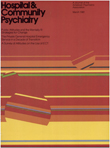Utilization of Medical Services by Psychiatric Patients
Abstract
The relationship between medical and psychiatric utilization of services was examined in a two-year study of two groups of psychiatric patients: high users of psychiatric services (more than ten visits in one year) and low users of psychiatric services (ten or fewer visits in one year). The high-utilization group made more than 60 per cent of the total psychiatric visits in the two-year period, but only 21 per cent of the total medical visits. However, patients in this group increased their utilization of medical services when psychiatric utilization was reduced, raising the question of whether high-utilization patients tend to substitute medical visits for psychiatric visits. In contrast, patients in the low-utilization group were able to hold their medical utilization constant when they reduced psychiatric utilization. Analysis of factors influencing utilization patterns might allow illness behavior in patients to be predetermined and lead to better and more cost-effective health care.
Access content
To read the fulltext, please use one of the options below to sign in or purchase access.- Personal login
- Institutional Login
- Sign in via OpenAthens
- Register for access
-
Please login/register if you wish to pair your device and check access availability.
Not a subscriber?
PsychiatryOnline subscription options offer access to the DSM-5 library, books, journals, CME, and patient resources. This all-in-one virtual library provides psychiatrists and mental health professionals with key resources for diagnosis, treatment, research, and professional development.
Need more help? PsychiatryOnline Customer Service may be reached by emailing [email protected] or by calling 800-368-5777 (in the U.S.) or 703-907-7322 (outside the U.S.).



